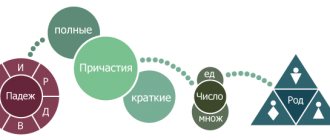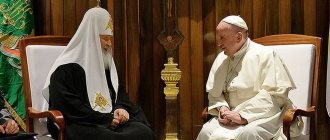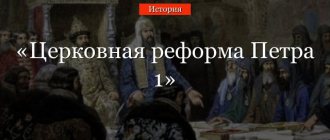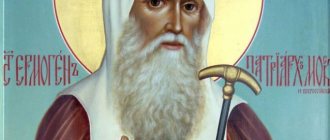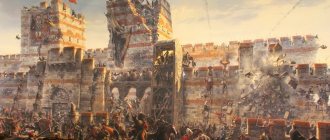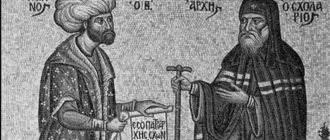What is the essence of the “Moscow – Third Rome” ideology. Let us briefly trace its history from its origins in Ancient Rome, through Byzantium and Rus'. We'll give you an assessment.
Nowadays, a variety of ideologies, worldview models and concepts float in society. One of them (and quite old!) is the “Moscow is the third Rome” ideology. Its essence is that the capital of our state, and our entire country, is perceived as the center of the Orthodox world, a direct heir to the sacred past of Byzantium, on the one hand, and on the other, the political and military genius of the “Eternal City”. When, how and why did this idea come to someone’s mind, and, most importantly, how did it happen that it was picked up and still supported by completely different people? To understand this, I propose to look into the past, but in two directions at once - socio-political and religious.
Pax Romana
Historically, Christianity was very closely associated with Roman culture, customs, laws and traditions. The land of the Jews at the time of Christ was under the rule of the Roman Empire. Yes, of course, carefully studying history, we can note that Palestine for the empire was one of the most unpromising provinces: there was little benefit, and there was more than enough worries. Jews were considered restless, ignorant, distant and incomprehensible. Their alienation from the “enlightened” Roman culture, as well as religious and national fanaticism, which was in no way justified in the eyes of the Romans, played a role here.
On the other hand, in the Gospel we see how even Christ encounters the harsh reality of the then imperial order. To whom did the chief priests and elders take Jesus when they conspired to commit murder? To the prefect of Judea, Pontius Pilate (Matthew 27:2), who, unable to cope with the crowd of bishops and Pharisees with a multitude of people who came to his door, gave the Savior to execution (Luke 23:24-25). It was the Roman soldiers who were assigned to guard the cave where the Body of Christ was buried (Matthew 27:65-66).
Further - more: let us remember the Acts of the Holy Apostles, which also describe numerous moments when the Savior’s disciples encountered the reality of Roman orders. Here is the conversion of Cornelius the centurion (Acts 10:1-48), and the murder of James, brother of John, by Herod Agrippa I (Acts 12:1-2), and the captivity of Peter (Acts 12:3-4), and many, many more facts. To the point that the apostles Paul and Peter were executed in Rome - and a series of terrible persecutions began. For almost three hundred years, the first Christians were rounded up, tortured, tortured, and subjected to terrible executions because they believed in Christ. Only the Edict of Milan in 313 ended this nightmare, allowing Christians to believe in their God and openly conduct worship services.
After this, the relationship of Christians with the Roman authorities developed in a completely different way. The fact is that in the 4th century. There is a radical change in the relationship between the Christian Church and the Roman state. By “Roman state” I mean, of course, Byzantium, because the inhabitants of the eastern part of the Roman Empire called themselves “Romans” and considered themselves - no less than - the heirs of the great state[1].
The decisive step towards change was the conversion of Emperor Constantine to Christianity. Secular and church historian-medievalist, Orthodox theologian, public figure and writer A.L. Dvorkin talks about it this way:
“It [the conversion] meant much more than just ending an era of persecution. The Emperor—the sovereign autocrat—immediately and inevitably became involved in the development of the Church, and, accordingly, the Church became more and more involved in important political decisions.”[2]
Despite the fact that Emperor Constantine was canonized by the Orthodox Church, one must understand that for most of his life he adhered to “fatherly” syncretic principles, in other words, a hodgepodge of various philosophical principles relevant in his time). Moreover, Constantine himself practically did not change anything in his attitude towards the country and methods of government, executing his former co-author under the Edict of Milan, Licinius, as well as his own son and wife. Moreover, this happened almost at the same time as the Council of Nicaea (325), which he headed[3].
By the way, he completely imitated his predecessors in this behavior. The fact is that order in the Roman Empire was not maintained by the Senate or powerful legions - no, the emperor was an autocrat and ruled everything at his own discretion. A. B. Ranovich, historian of antiquity, translator, Doctor of Philosophy, cites Emperor Augustus as an example, saying that he...
... “five times (in 29, 18, 13, 11 BC and in 4 AD) he cleansed and reorganized the Senate <...> declares himself the restorer of freedom; The same is said in inscriptions, statues erected in honor of freedom, and coins. Claudius, Nero, Galba, Vespasian and other emperors, even Trebonian Gallus, were declared defenders of freedom. But this “freedom” in reality meant the cessation of political public life, the subordination of everyone to the will and even the tyranny of the dictator.”[4]
The further fate of this theory and its criticism
The concept of Elder Philotheus was criticized from the very beginning. In particular, its opponents said that Philotheus of Pskov himself was not the author of these ideas. The following arguments were given in favor of the fact that he was not the first person who decided to compare Moscow and Rome:
- Earlier, Metropolitan Zosima called Moscow the successor of Constantinople, and Ivan III the new ruler of the new Byzantium.
- In some monuments of ancient Russian literature, Rus' was described as the heir of the Roman Empire.
- There were rumors in the society of that time that the legendary Monomakh hat was of Byzantine origin.
In such cases, the elder’s comrades responded that Philotheus was an educated person, so he could compare ideas from different sources and, on their basis, develop his own ideological concept.
The idea of the “third Rome” expresses the concept of the Russian people being chosen by God
During the years of struggle against the Old Believer movement, the letters of Philotheus of Pskov were banned, since followers of Old Believer ideas considered the Old Testament Moscow Church to be the Third Rome, which ran counter to the official position of the Russian Orthodox Church.
After achieving the set goals, the concept itself and its author were forgotten for a long time. Already in the 19th century, the letters of Elder Philotheus were published again, his doctrines were discussed in society, and became the basis for the emergence of various philosophical theories.
In Soviet times, the words of the elder were interpreted only in a political and ideological context, without a hint of spirituality. After the collapse of the Soviet Union, the elder’s words were again spoken of as spiritual guidance. Believers began to view the historical path of the Russian state as the path to God.
Fashionable religion
The business started by Konstantin led to unusual consequences. The previously persecuted religion acquired extraordinary proportions. Yes, yes, don’t be surprised, Christianity then became a powerful trend. Over time, the official title of the ruler began to include the words “faithful king in Christ God,” and the management system absorbed more and more elements of the Christian worldview and doctrine.
If until now the admirers of Christ were executed and killed, now...
... “from the 4th to the 6th centuries. various emperors, especially Constantine himself, Theodosius I and Justinian I, granted the Church enormous privileges of various kinds, gave it part of the legal power of the state and left the entire sphere of social security to it. In the holy places of Christianity and on the tombs of martyrs, magnificent temples were erected, and the new capital, Constantinople, was no longer decorated with temples of Victory and Justice, but with churches dedicated to Christ - the Wisdom of God (St. Sophia) and Christ - the Peace of God (St. Irene )"[5].
Moreover, the emperors, having accepted the new faith, increasingly used it as a tool to achieve their political goals, including maintaining order and unity in the Empire. Christianity, having received unprecedented opportunities, began to accept more and more people into its ranks.
The new faith became very fashionable, with its help a person could achieve a lot. Needless to say that not all people, wanting to get a good and profitable position and a stable financial flow, accepted Christianity out of sincere motives?
Map of New Rome
Expression value
The meaning of this phrase should be considered not so much in a political, but in a religious context. The two previous Romes were adherents of the true faith, but later changed their religion, for which they were punished.
After the fall of Rome, the true faith was preserved only in the Muscovite state
Consequently, Moscow became the successor to Orthodoxy, and therefore the city was destined to become the “third Rome.” Faith rests on Moscow, and if it falls, it will not be possible to create a new Rome.
In the political aspect, such parallels were drawn in order to emphasize the promise of the young state. Comparing the young capital with the legendary city had great ideological significance.
Cult of Rome
It is logical to assume that after the Baptism of Rus', Vladimir will want to adopt the Byzantine model of relations between the state and the Church. Indeed, along with the new faith, many new laws came to Rus'.
In general, Russian princes periodically behaved like Byzantine emperors. Yes, the cooperation of the princely and church authorities brought great results, but not all of them were good. Let's talk about those that weren't.
One of the first examples is the interference of the prince in the appointment of a bishop. This is how Prof. talks about it. E. E. Golubinsky, historian of the Russian Church:
“The first direct news of the election of a bishop as an appanage prince is found in the chronicle under the year 1126; then they go continuously until the end of the period <...> the right to elect a bishop belongs not to the metropolitan, but to the prince and citizens. In 1185, Metropolitan Nicephorus 2 appointed a certain Nicholas the Greek as bishop of Rostov without communicating with the Grand Duke Vsevolod Yuryevich, but the Grand Duke did not accept the latter and forced the Metropolitan to appoint his own candidate.”[6]
Moreover, the historian goes on to directly say that such a practice is nothing more than “a reproduction of what was done before us in Greece.”[7].
The interference of princes in church affairs continued later. One can recall, for example, how Andrei Bogolyubsky, glorified by the Church as a faithful believer, tried to carry out a scam with the election of his own bishop (of Vladimir), Fyodor, in return for Bishop Nestor of Rostov, who disagreed with his policies. But Andrei did not work well with the overly active Fedor. He was then exiled and, after a trial by the people's council, killed in 1172.
Why did this happen? What is the reason for this behavior of the princes?
And we finally move on to the actual religious reasons for the current situation and again turn our gaze to antiquity, to the time of the Roman emperors, whose power was sacred. This means that the emperor was then considered not just the supreme ruler, but even had the status of someone who should be given religious worship.
Of course, this was not always the case. At first, the inhabitants of the Roman state had many religious ideas. They believed in various supernatural forces - very powerful, surpassing human capabilities and controlling his destiny. They were worshiped, prayed for, rituals were performed and sacrifices were made - in general, this was a common pagan practice.
In turn, such a worldview gave rise to a person’s feeling of anxiety, danger, uncertainty in the future and his security in the present. This position forced the ancient Romans to seek a qualitatively different, more reliable relationship with the world of the supernatural - this is how the desire to gain help and power greater than they had ever received was manifested.
Over time, the Roman rulers tried to modify these beliefs, making them uniform and common to everyone. This was done by sacralizing power and its head. As Dworkin writes:
“The cult of Dea Roma was practiced in Smyrna already in 195 BC. This cult increased markedly due to the popularity of the empire in the provinces, which were pleased with the increased level of government under the imperial order. Already in 29 BC there was a temple of Rome and Augustus in Pergamon. This cult, the object of which was the ruler, who is the embodiment of the state, or rather his “genius”, that is, the spirit living in him, began to spread very quickly. Soon he acquired a developed system of priests, existing on state subsidies, organized on a territorial basis and taking the widest part in public life”[8].
At one point, the Emperor of Rome even received the status of "Pontifex Maximus" (high priest). Interestingly, even Constantine the Great does not refuse this title. Only his sons do this, prohibiting public sacrifices and destroying pagan temples[9]. This is how the cult of Rome and its emperor was born, which later greatly influenced the Roman Church itself.
The concept of sacralization of power has changed over time, but not so fundamentally. This idea (sacralization of power) became the personification of chapter 7 from the book of the prophet Daniel, which tells about the prophet’s interpretation of the dreams of Belshazzar, king of Babylon. Here is how A.P. Kartashev, theologian, historian of the Russian church, church and public figure, writes about it:
“This design has become generally accepted and classic for all Byzantine chronographs. The fourth beast, iron, i.e. The Roman Empire, according to this scheme, becomes the frame, vessel, armor and shell of the eternal kingdom of Christ, and therefore it itself acquires some symbolic resemblance to this eternity in history. Before His birth, the Lord was included in the Roman census as a citizen of the empire. This gave the Roman Empire, especially after its Christianization, historical indestructibility until the Second Coming”[10].
As Rome weakens, its status passes to Constantinople, which is already considered the heir and executor of the mission of the “eternal city”[11].
The essence and main provisions of the concept
The goal of the new concept was the centralization of political, religious and ideological processes in one city - Moscow.
The main provisions of this theory were obvious:
- The Russian state, led by its capital, was recognized as the successor to the Roman Empire, which had lost its former greatness.
- The main goal of uniting the lands was the eradication of paganism and the strengthening of the Christian faith.
These goals were subsequently successfully implemented and laid a good foundation for the future development of the state.
Interesting to know! It was Prince Vasily III who was first named emperor in an official document. This is what the Emperor of the Roman Empire Maximilian I called it in a treaty between the states.
This idea was supported by the chroniclers of those times. They argued that it was not in vain that Moscow, like Rome, was built on hills. The Moscow Kremlin was built on the highest of them, Borovitsky Hill.
This status of Moscow was also beneficial to Western states that proclaimed Christianity as the official religion, because if the Russian state positioned itself as a defender of Christianity, it could not remain aloof from the confrontation with the Ottoman Empire.
Moscow is the successor to the historical mission of the first and second Rome
By the end of the next century, official documents began to increasingly call Moscow “Constantinople,” “Third Rome,” and “New Constantinople.”
The birth of the ideology “Moscow is the third Rome” in 1589
In Rus', the idea of the sacredness of the state, its “sacred” mission, began to manifest itself in earnest from the end of the 15th century. There were two reasons for this:
1) Accumulated distrust of the Greeks (rituals are not like in Rus', the rites are different, and even closer to Catholics). The peak was the Ferraro-Florentine Union (1439), when almost all Greek bishops signed an agreement with the Roman Catholic Church on unification, after which Constantinople began to be considered as having fallen away from Orthodoxy. And although the Greeks subsequently abandoned the union, the idea of them “as weak in faith” only became stronger.
2) The fall of “Tsargrad” itself in 1453 under the onslaught of invaders:
“The poor “Romans” experienced this as the end of the world. But their disciples and spiritual children - the Orthodox Slavs, who firmly grasped the lesson about the ongoing sacred history with the possibility of moving its center, came to the conclusion that after the fall of two Romes, the Third Rome - Moscow will stand until the end of the century, as a new continuation of the world empire, as the mystical center of world history"[12].
If the “Second Rome” defended Orthodoxy from the Persians and Arabs, then Rus', in the understanding of the residents of the politically rising Moscow, now defended the world from the “infidels” in the person of the “Asian darkness”, the Tatar-Mongol yoke[13].
One of the first to express the idea of transferring this sacredness was Metropolitan Zosima in his “Notice of Easter for the eighth thousand years,” comparing Prince Ivan Vasilyevich with Constantine the Great, and considering Moscow the heir of Constantinople[14]. The second to “notice” in his message to Vasily III was the Pskov elder Philotheus, who, among other instructions to the ruler, actually declares the prince the ruler of all Christian states: “all Christian kingdoms have come together into one of yours, that two Romes have fallen, and the third stands, but there will not be a fourth”[ 15]. In Philotheus’s concept, the king personified the entire people[16] and had the status of not just a ruler, but actually a priest[17].
In other words, the same idea returns as was in Ancient Rome, namely: the ruler is the “Pontifex Maximus”, “high priest”, only the pathos changes - from pagan to Orthodox.
Officially at the state level, the idea of “Moscow – the Third Rome” was outlined in 1589 in the charter establishing the Patriarchal Throne in Russia:
“Even though the old Rome fell by the Apolinarian heresy, the Second Rome, which is Costantinople, is possessed by the Hagarian grandsons - from the godless Turks - we possess; yours, O pious king, the Great Russian Kingdom, the Third Rome, surpasses all others in piety, and all the pious kingdom in yours has gathered into one, and you are the only Christian king under heaven who is called throughout the entire universe, among all Christians.”[18]
The personality of Elder Philotheus
Little information is available about the life of the founder of the concept of the Third Rome; the monk Philotheus was not a canonized Saint. It is known that he spent many years traveling, wandering through cities and countries of Europe. He lived for several decades on Mount Athos, devoting this time to prayers and reflections on the Eternal.
Philotheus’s theory “Moscow is the third Rome” determined the spiritual and historical destiny of Russia in the context of the entire world history
After long travels, the elder returned to Russia. During this period, he had conflicts with the authorities, after which Philotheus became a prisoner of the Sarsky Monastery. Later he became its rector. In the monastery, under the leadership of the elder, a large icon-painting workshop was opened, and the monastery itself became a kind of linguistic center, specializing in translations from Greek.
Interesting to know! One day the elder predicted that the end of life on Earth would come when one of the people made a deal with the devil. This period will be associated with terrible persecution of Christians, whom they will try to break spiritually and destroy physically.
The devil himself will appear on Earth to seduce the largest number of people and lead many Christians astray. Only the chosen ones will be awarded the Kingdom of God - those who are not afraid of persecution and can resist Satan’s tricks. Many Christians who suffered from the anti-religious campaign of the Bolsheviks considered this period to be a harbinger of the events that Elder Philotheus spoke about.
Notes[edit]
- Zolnikova N.D.
Eschatology of the Yenisei Old Believer scribe of the chapel agreement Isai Nazarovich (1970s) // Domestic history. — 2000. — No. 5. An electronic version of the article was used from the now defunct Auditorium website. - Quote by: Deinikov R. T.
On the issue of the withdrawal of Christians from the Crimean Khanate in 1778 // Questions of history. - 2014. - No. 4. - P. 158. - www.runivers.ru
- 3rm.info: “ICON “MOSCOW-THIRD ROME” (2011). Brief explanations"
- Lector's Ax
Content
- 1 Origin and essence of the concept
- 2 Article by E. Shmurlo from the “Encyclopedic Dictionary” of Brockhaus and Efron 2.1 Succession of inheritance
- 2.2 Second Rome
- 2.3 Fall of Constantinople
- 2.4 Third Rome
- 2.5 Literature
How was the royal dynasty of Rus' broken?
(Rus meant the entire White World - Race).
After the Time of Troubles, the destruction and capture of the capital - the Lord of Veliky Novgorod with the fortress of Castrum, it was decided to choose a New Tsar. For this purpose, a large list of applicants was compiled: according to the right of the ladder, these could only be representatives of the Family (Royal Family). The ladder principle assumed the transfer of inheritance rights first horizontally - between brothers, from older to younger until the end of the generation, and only then vertically - between generations, again to the eldest of the brothers of the younger generation.
All Rurik princes were considered brothers (relatives) and co-owners of the state and the entire country.
The fate of the dynasty was decided at the Zemsky Sobor when the "deputy" Gavrila Pushkin made a speech and equated the Royal family with external claimants to the kingdom, such as the Polish and Swedish claimants.
And here the most interesting thing begins, the applicants, and this is more than 1000 people, and by order (??) of the Polish Tsar Sigismund, they were sent to Poland... There they were placed on the territory of the Polotsk and Vitebsk voivodeships. These were mainly representatives of the Royal Family.
Those who remained were moved to Kineshma to a separate reservation, which was named in their honor - Turuntaevka (Tur-Prince, Tai-the-Great) #turuntai.
This was practically the end of the royal dynasty.

